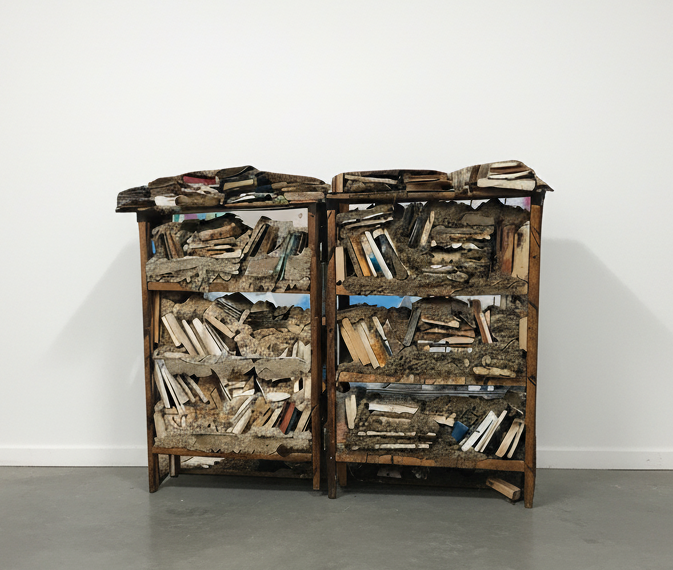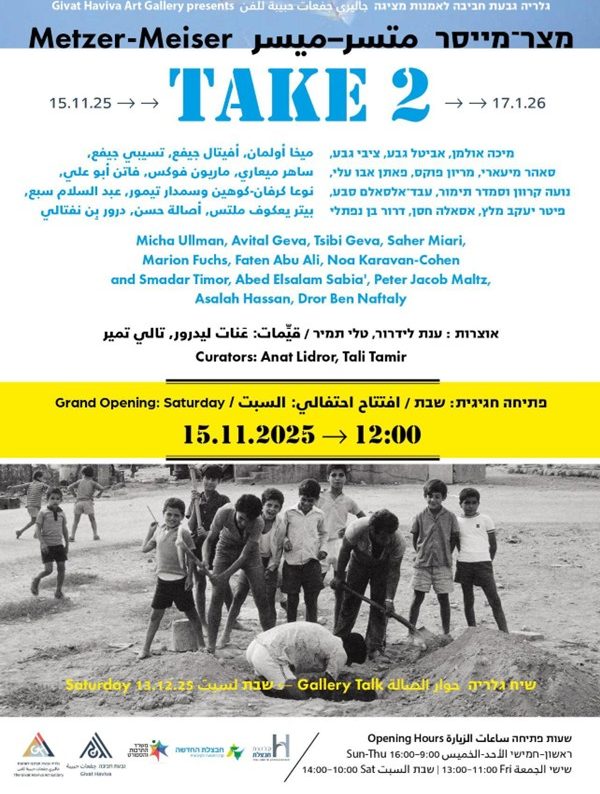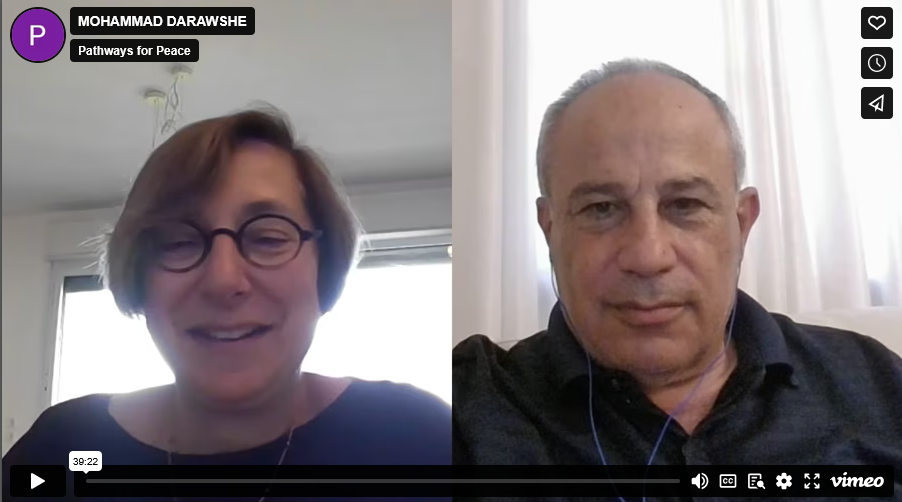Artists: Micha Ullman, Avital Geva, Tsibi Geva, Saher Miari, Marion Fuchs, Faten Abu Ali, Abed Elsalam Sabia’, Peter Jacob Meltz, Asala Hassan, Dror Ben Naftaly.
.Interviews and video: Noa Karavan and Smadar Timor
.Curators: Anat Lidror and Tali Tamir
__________________________________
Metzer-Meiser: Take 2 explores, resonates, and converses with the iconic Metzer-Meiser project produced in October 1972 in the area between Kibbutz Metzer and the village of Meiser, featuring installations that involved exchanging soil, scattering books, burying objects, and privatizing fields. The four original participants were: Avital Geva, Micha Ullman, Moshe Gershuni, and Dov Or Ner. In Metzer-Meiser: Take 2, Ullman and Geva display works that revisit the original event, alongside nine other artists who both revisit it and create a statement of their own. Together with its retrospective view, Metzer-Meiser: Take 2 looks towards the future, while shaping an understanding of the different narratives that emerged regarding a single artistic event.
The Givat Haviva Art Gallery, under the gallery’s curator Anat Lidror and independent curator Tali Tamir, have initiated an action and exhibition that will explore, debate, and allude to the iconic Metzer-Meiser project held in 1972 at Metzer-Meiser and the intervening land, from a 53-year perspective. In the historiography of Israeli art, the original project was considered the first artistic endeavor to take place in a joint Jewish-Arab space, though the four artists who initiated and implemented it were Jews. This project marked the initiation of conceptual art in Israel and embodied a new language that involved linking art and life, action in space, and environmental-geo-political and social consciousness. At the same time, it was inspired by the kibbutz environment within Israel’s geographical periphery, shared as it is with Palestinian-Arab towns; a project born in Ein Shemer, substantiated in Metzer, and drawing from the kibbutz ideology of co-existence between the two nations.
Micha Ullman executed an operation that received wide exposure and became emblematic of the project: exchanging soil between Kibbutz Metzer and the adjacent Arab village of Meiser, by digging two pits and switching the earth within them. The pits were dug by young boys from the kibbutz and the village. At the Metzer-Meiser junction, Avital Geva scattered books rejected by the Amnir paper recycling facility in Hadera and invited residents of the two towns to come and pick up books. Dov Or Ner issued an appeal to the residents of Metzer and Meiser in Hebrew and Arabic, seeking personal objects that were not in use, which he then buried together in a shaft dug in the earth, as an archeological deposit to be uncovered in the future. Moshe Gershuni parcellated (designated plots) in the fields of Metzer, granting each family in the kibbutz its own share of land, a prophetic act that anticipated the privatization process in the kibbutzim decades later and aroused resistance and anger within the kibbutz.
Metzer-Meiser: Take 2 takes place at a charged historical moment for Jewish-Arab relations in the country and in the region; it includes references to the current quandaries. Although Gershuni and Or Ner are no longer with us, Micha Ullman and Avital Geva will display works that correspond with those in the original project and with the country’s current circumstances: Ullman dug two chair-shaped pits, placing the heaps of sand extracted within the gallery; Avital Geva presents “Books drowned in a swamp” – books embedded in a concrete floor (displayed outside), as well as “The Jewish library” within the gallery – a concrete-sealed bookcase, reflecting the loss of fundamental values affiliated with the Jewish ethos.

Metzer-Meiser: Take 2 examines the divergent memories retained by members of Metzer and residents of Meiser regarding the artistic event that took place in 1972, reveals the different narratives that emerged regarding this event over the years, and explores the mutual bond between the Jewish and Arab towns. Alluding to Ullman’s soil-based work and Or Ner’s object burial, Saher Miari displays the content of the pits and the objects within a transparent column. In another work he engages with the art of sculptor Yechiel Shemi and displays “The cave”, from which the diggers’ conversing voices emerge. Abed Elsalam Sabia’ displays a large-scale landscape painting overlooking the joint area between Metzer and Meiser, flanked by a clothesline featuring clothes he gathered from the two towns. Faten Abu Ali displays another version of her efforts at botanical grafting of olive trees with other trees, as a metaphor for mixing different species. Asala Hassan interviews young people from Meiser on the connection they feel to their residential area and translates select sentences into Morse code. Her work centers on the issue of understanding / not understanding, distress and well-being.
Tsibi Geva copies the dual Metzer-Meiser format to the biographical domain and inscribes in the space two names of personal friends – Yoav, Nagib – one from Metzer and the other from Meiser. He includes a photograph of his father, architect Kuba Gever, a member of Kibbutz Ein Shemer who designed Meiser’s mosque and appears in the photograph during construction. In her paintings, artist Marion Fuchs, a member of Kibbutz Metzer, follows the morning walks by residents of Metzer and Meiser along the two sides of the fence erected after a terrorist attack on the kibbutz, highlighting the proximity and otherness within their reciprocal gaze. Peter Jacob Meltz drew and linked pieces and compositions gathered from the two sites. Photographer Dror Ben Naftaly presents three spatial photographs of adjoining Jewish and Arab towns, isolated from their landscape. In preparation for the exhibition, documentarians Noa Karavan and Smadar Timor interviewed Micha Ullman, Avital Geva, members of Metzer, and residents of Meiser, who shared personal memories of the original 1972 event and how they perceive the relations between the two towns, each from their own point of view. The visual journal created, emphasizing differences and distinctions experienced by each side, seeks to arouse discussion and to form the heart of the exhibition.
The exhibition will include an archive wall concisely reconstructing the project’s four original operations and presenting documents from Kibbutz Metzer’s archive that attest to the special affinity between the two towns in the past and present. The archival files reveal a mutual relationship centering on a thriving supportive neighborly alliance over many years. This relationship is offered as a model of Arab-Jewish neighborly relations for Israeli society in general and kibbutz society in the geographical periphery in particular. After two years of war and the lingering effects of violence, pain, and shifting views on both sides, the hyphen connecting Metzer and Meiser has the power to inspire the younger generations even within Metzer and Meiser themselves.
Metzer-Meiser: Take 2 seeks not only to reconstruct and evoke forgotten memories, but primarily to investigate the complex issue of everyday neighborly relations between Jews and Arabs and indicate their supreme significance for the future of this land. By recreating the different insights and distinct memories, the exhibition offers an honest and complex discourse on shared experiences within the Israeli space.
Anat Lidror and Tali Tamir, curators of the exhibition
__________________________________
Opening: Saturday, November 15, 2025, 12:00
Location: Givat Haviva Art Gallery
Curators: Anat Lidror and Tali Tamir
Panel discussion: December 13, 2025, 12:00
Closing: January 17, 2026





